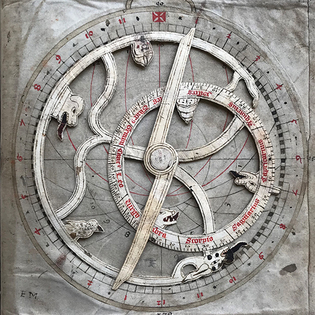
Photo: Laura Phillips ’20PHD. MS 26, Cushing/Whitney Medical Library, Yale.
A sixteenth-century astrolabe.
View full image
“Would you like to know something about the stars?” the eagle asks his ward, Geffrey, the narrator in Geoffrey Chaucer’s dream-poem The House of Fame (ca. 1374–85).
“Certainly not,” Geffrey replies. “I am too old!”
“A pity,” says the eagle.
The poem’s author might have agreed. As if in response to Geffrey’s ageist self-deprecation, Chaucer returned to the topic of celestial edification a few years later in Treatise on the Astrolabe (ca. 1391), which he wrote for his ten-year-old son, Lewis. Although “Little Lewis” (Lytyl Lewys), as he is affectionately known in the text, is identified as the intended audience, the boy also serves as a stand-in for audiences of all ages, for “every person . . . that readith [or] hearith this little treatise.”
The 33 still-extant copies of the Treatise attest to the breadth of its readership; its numbers are second only to Chaucer’s most famous text, The Canterbury Tales. The Beinecke Library’s fifteenth-century copy is among these surviving manuscripts, though it lacks one important feature: illustrations. Today, only 11 volumes preserve the diagrams that are believed to have accompanied Chaucer’s original text. Altogether, these illustrations define a distinctive device that historian Catherine Eagleton has termed the “Chaucerian” astrolabe.
A prime example of that instrument (pictured here) can be found at Yale’s Medical Historical Library. This moveable, planispheric model of the universe appears at the end of an untitled English manuscript known as MS 26 (1553). Donated in 1949 by Louis M. Rabinowitz, MS 26 centers on the subject of medical astrology.
In sixteenth-century England, medical astrology was by no means fringe. It was a curricular requirement for postgraduate study in medicine, and it figured prominently in the training of most physicians, barber surgeons, and local healers.
Bound up with theories of humoral medicine and celestial-terrestrial correspondence, medical astrology was, in the eyes of its remaining early-modern practitioners, built upon a “rational” substrate: the precisely calculable and predictable movements of the heavens. These movements, in turn, were thought to move “humors” or fluids—e.g., blood, phlegm, etc.—within the human body. When the body’s humoral fluids were in balance, a person was considered healthy. When they were out of balance, illness allegedly followed.
Accordingly, a key consideration in medical astrology was timing. While sundials and mechanical clocks satisfied most basic time-telling needs, some physicians turned instead to the astrolabe. They used this instrument to quickly figure the time of day or night at any time of year, to assess when curative treatments should be applied—or avoided altogether. Such physicians, scholars claim, served persons of high nobility or even royalty. The astrolabe in MS 26, however, tells a different story. Made of vellum, it is an object of modest means, particularly when compared with a finely crafted metal instrument like the Hartmann Astrolabe (1537) at the Yale Peabody Museum of Natural History. The prestige of this astrolabe, it seems, lay not in its materials but in its connection to a national intellectual tradition, to Chaucer’s Treatise on the Astrolabe.
What does a “Chaucerian” astrolabe look like? For the most part, it looks like the physician’s astrolabe from MS 26. This instrument boasts two of the Chaucerian type’s most distinctive features: the y-shaped rete—the perforated, rotating disk representing the sky—and the accompanying zoomorphic figures. These animals are star-pointers. Their tongues, beaks, and other appendages point to a collection of fixed stars and constellations, whose positions are measured with reference to the ecliptic—here represented by the circle listing the 12 signs of the zodiac.
Among these creatures, the dog is of particular interest. Representing a now-extinct, square-faced, floppy-eared hunting dog known as a Talbot, this figure points to Alhabor, or Sirius, the brightest star in the constellation Canis Major. The bird and dragon’s head are also figures of note, though there remains some ambiguity about the stars they point out: the positions of the fixed stars—despite their name—changed by several degrees between 1391 and 1553.
In the end, the story that unfolds from the physician’s astrolabe is one of enduring intellectual tradition. Or, as Chaucer described nearly 150 years earlier in The Canterbury Tales, it speaks to a medical practice “grounded in astronomye.”
 loading
loading
1 comment
-

Laura Phillips, 3:18pm October 31 2021 |  Flag as inappropriate
Flag as inappropriate
The comment period has expired.For more information on this topic, please visit the Medical Historical Library’s new online exhibition “Medical Astrology: Science, Art, and Influence in early-modern Europe”: https://onlineexhibits.library.yale.edu/s/medicalastrology/page/introduction